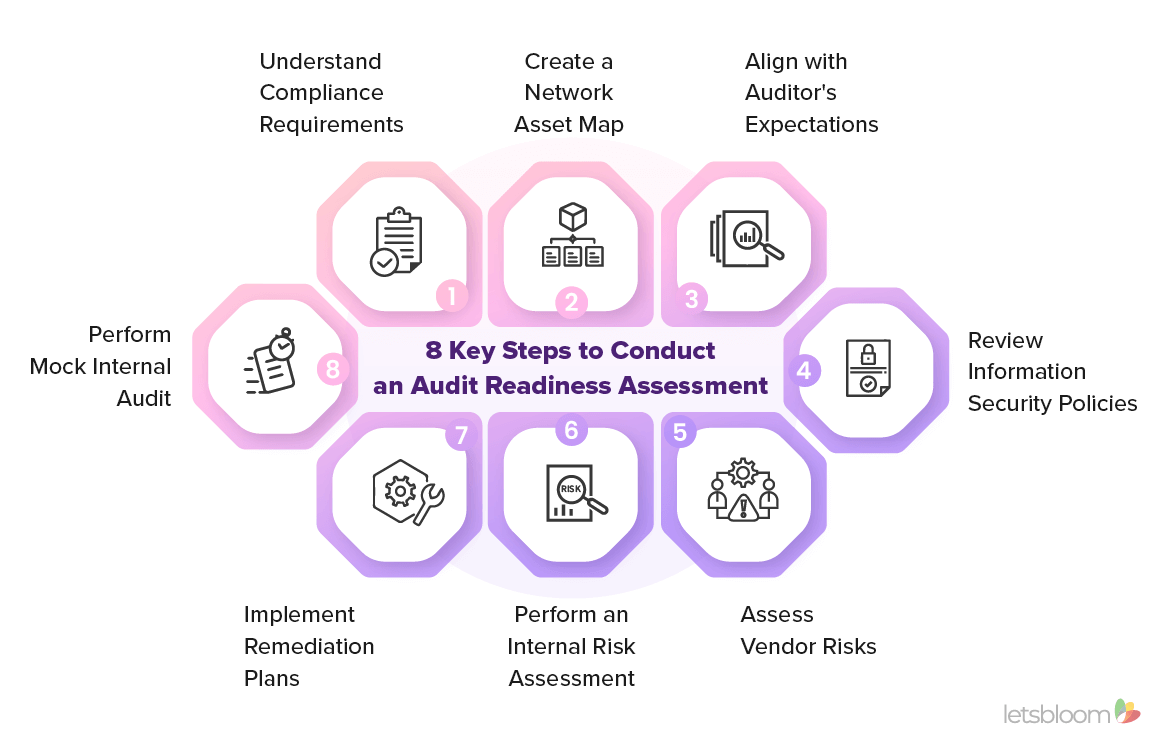The Importance of Audit Readiness Assessments

Ritika Jain
Oct 18, 2024


In today's highly regulated environment, audits are vital in helping businesses maintain regulatory compliance, build trust, and gain a competitive edge. However, compliance audits can be daunting, and this is where audit readiness assessments come into play.
By conducting audit assessments, businesses can proactively prepare for audits, ensure they are fully compliant, and avoid any last-minute scrambling that could otherwise jeopardize a successful audit outcome.
What is an Audit Readiness Assessment?
An audit readiness assessment is a proactive process to evaluate an organization's preparedness for an upcoming audit. It thoroughly reviews policies, controls, and procedures to ensure they align with relevant regulatory benchmarks and industry standards. By identifying potential gaps or weaknesses, the assessment allows organizations to address issues before the audit, thus minimizing non-compliance risks and ensuring smoother audit processes.
These assessments often occur months before the formal audit, providing ample time for organizations to understand their current compliance posture. The insights gathered can guide organizations in closing gaps, ensuring they are prepared and confident when the audit day comes.
Why Businesses Should Conduct Audit Readiness Assessments?
Undertaking an audit readiness assessment offers several advantages beyond audit preparation. Here are some key benefits:
- Understanding Regulatory Benchmarks: Audit readiness assessments provide a clear picture of the regulatory standards and benchmarks your organization needs to meet. This understanding allows for targeted improvements and ensures compliance efforts align with specific industry requirements.
- Strengthen Relationships with Auditors: Organizations can foster positive relationships with auditors by demonstrating a proactive approach to compliance. This can lead to smoother audit processes and more constructive feedback.
- Aligning Internal Teams: By focusing on audit readiness, organizations can ensure that all teams—whether IT, legal, or operations—are working cohesively towards compliance goals.
- Early Risk Identification and Remediation: One of the most significant benefits of audit readiness assessments is detecting and mitigating risks early on. This proactive approach significantly reduces the risk of substantial findings during the actual audit.
- Cost Efficiency: By identifying and addressing compliance issues before the audit, organizations can avoid the rush of last-minute fixes, which are often more costly and time-consuming. Moreover, it helps prevent penalties and reputational damage associated with audit failures.
8 Key Steps to Conduct an Audit Readiness Assessment

Preparing for an audit readiness assessment requires a structured approach. Here's a step-by-step guide to ensure your organization is audit-ready:
1. Understand Compliance Requirements: Start by identifying your business's industry-specific regulations and standards. Understanding these will help tailor your readiness assessment to the correct benchmarks.
2. Create a Network Asset Map: Develop a detailed map of your network infrastructure. This visual representation will be vital during the audit, helping auditors understand your system architecture.
3. Align with Auditor's Expectations: Engage with your audits early to clearly understand their requirements and expectations. This proactive communication helps you tailor your documentation and preparation efforts effectively.
4. Review Information Security Policies: Conduct a thorough review of your policies. Update and refine them to ensure they are up-to-date, comprehensive, and aligned with internal processes and external regulatory requirements.
5. Assess Vendor Risks: Conduct a vendor risk assessment to evaluate your third-party providers' security and compliance posture. This is crucial, as vendors can introduce risks into your organization and impact your regulatory standing.
6. Perform an Internal Risk Assessment: Examine your organization's risk landscape to identify potential vulnerabilities and evaluate the effectiveness of current controls. This should cover both technological and procedural aspects of your operations.
7. Implement Remediation Plans: Based on your assessments, identify any gaps between your current state and the required compliance standards. Develop and implement a detailed plan to address these gaps.
8. Perform Mock Internal Audit: Simulate an audit by performing an internal audit. This mock audit will provide insights into areas that need further attention before the actual audit occurs.
Conclusion
Audit readiness assessment is the right way to prepare for an audit. However, addressing the issues identified during the assessment does not mean your company will remain compliant. Things as simple as a missed software patch during the audit become exceptions in the final report.
Continuous compliance monitoring is the only way to remain compliant. letsbloom’s Compliance Automation Platform offers continuous compliance posture monitoring to track and remediate compliance gaps in real-time to stay compliant 24x7. Automate control monitoring and evidence collection, streamline remediation workflows with AI-driven assistance, and get audit-ready 10x faster without compromising quality and cost.
Don't wait for the last-minute scramble—start your audit readiness journey now. Contact letsbloom to accelerate your audit preparation and be audit-ready within weeks.










